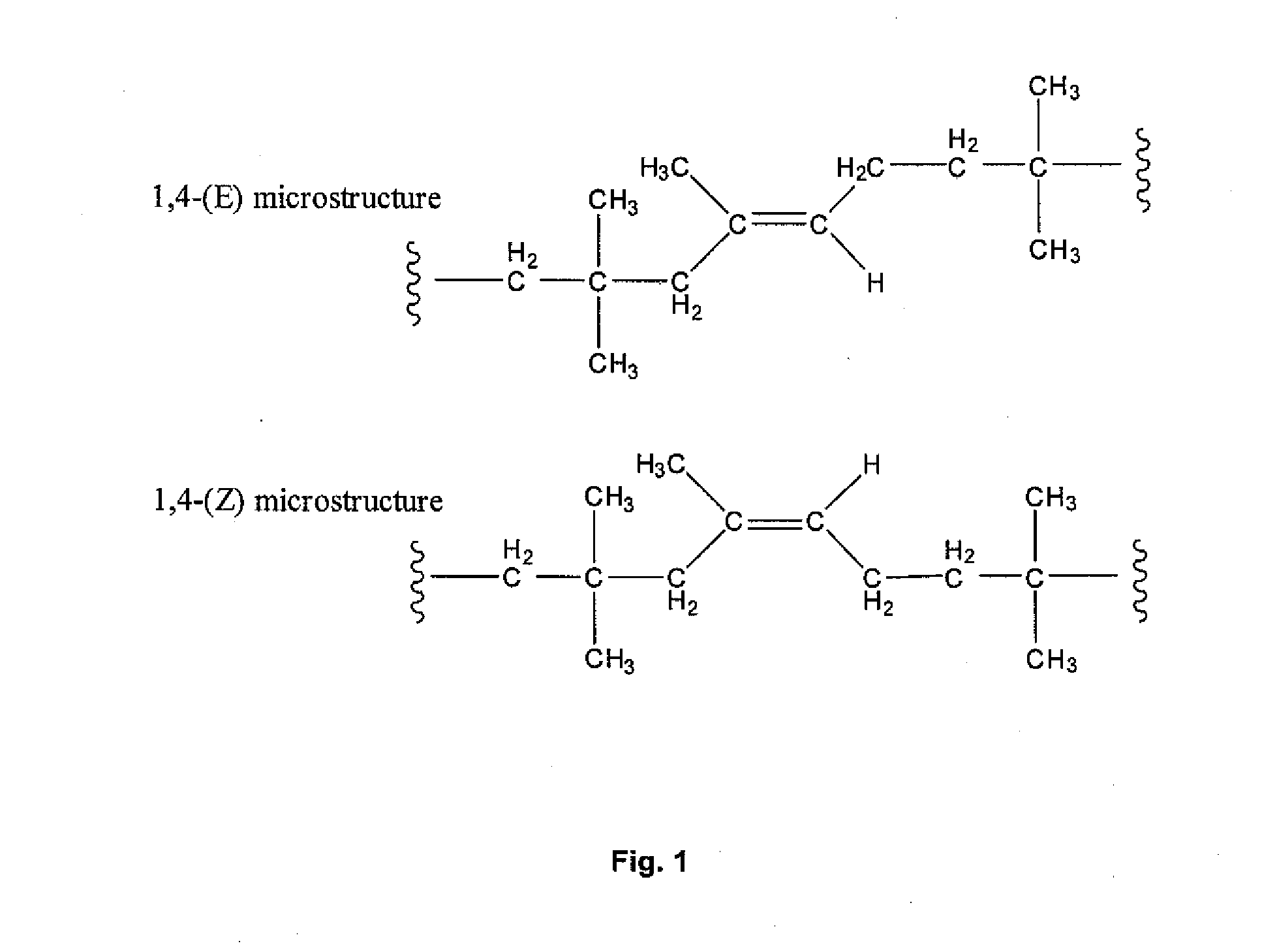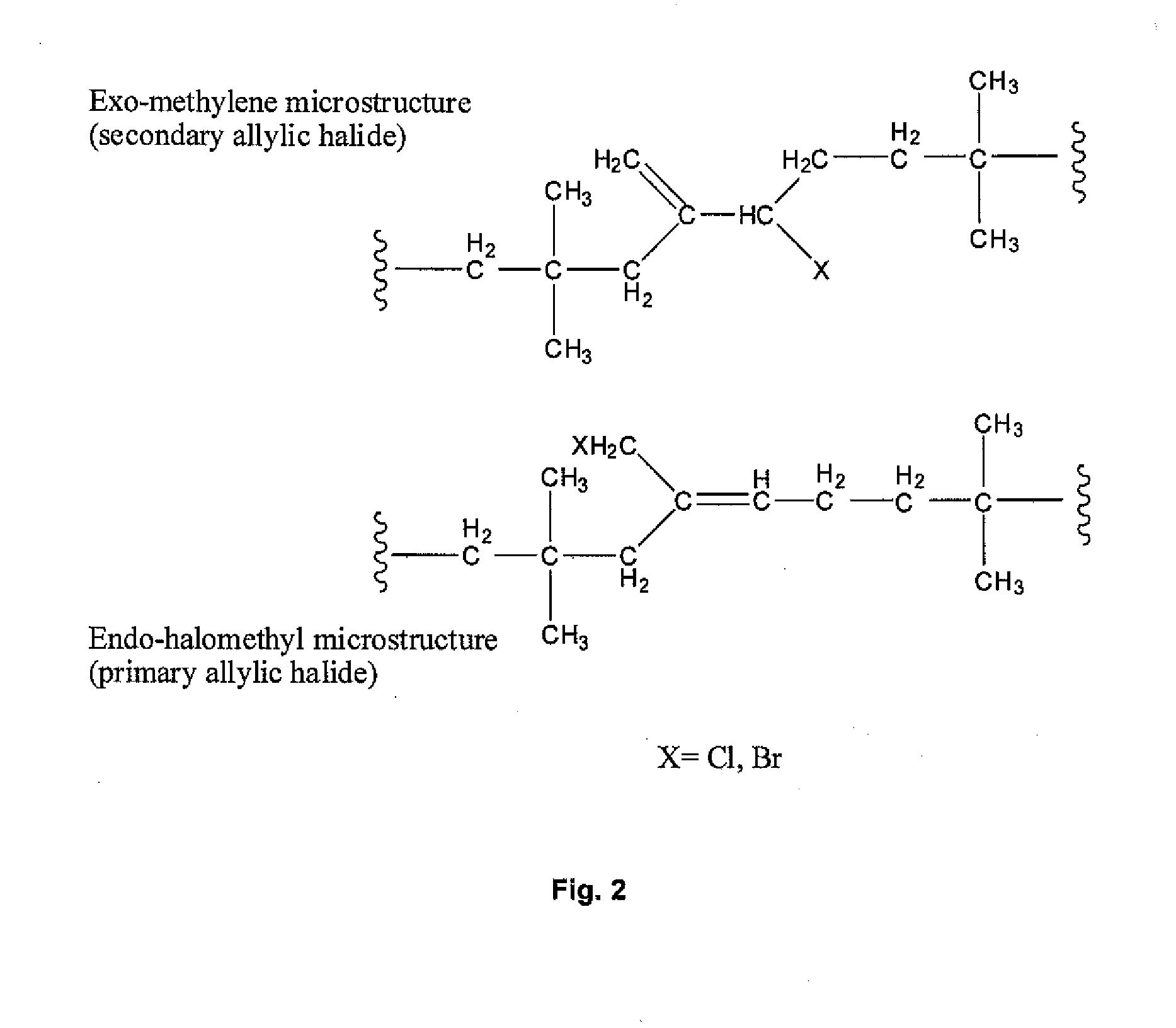Halogenated Butyl Rubber Having Superior Reactivity
a technology of halogenated butyl rubber and superior reactivity, which is applied in the direction of organic compound/hydride/coordination complex catalyst, physical/chemical process catalyst, chemical apparatus and processes, etc., can solve the problem that chlorobutyl rubber is not commonly used
- Summary
- Abstract
- Description
- Claims
- Application Information
AI Technical Summary
Benefits of technology
Problems solved by technology
Method used
Image
Examples
working examples
Materials and Methods
[0064]Bromobutyl rubber (LANXESS BB2030, allylic bromide content about 0.15 mmol per gm) and chlorobutyl rubber (LANXESS CB1240, allylic chloride content about 0.22 mmol per gm) were used as supplied by LANXESS Inc. (Sarnia, Ontario, Canada). The following reagents were used as received: 1,8-bis(dimethylamino)-naphthalene (Proton-sponge® 99%, Sigma-Aldrich, Oakville, Ontario, Canada); zinc stearate (90%, Fisher Scientific, Ottawa, Ontario, Canada); iron naphthenate (80% in mineral spirits, Alfa Aesar, Ward Hill, Mass., USA).
[0065]1H NMR spectra were acquired in CDCl3 on a Bruker Avance-600 spectrometer (available from Bruker, Milton, Ontario, Canada) with chemical shifts referenced to tetramethylsilane. Solid-state reactions were done using a Haake Polylab R600 internal batch mixer (Thermo Scientific, Waltham, Mass., USA).
example 1
Solution Dehydrohalogenation of Bromobutyl Rubber (for Comparison)
[0066]Bromobutyl rubber (17.5 g, 2.26 mmol allylic bromide, 90:10 ratio of secondary allylic bromide to primary allylic bromide) and 1,8-bis(dimethylamino)naphthalene (1.46 g, 6.82 mmol) were dissolved in xylenes (350 mL), then heated to reflux with stirring. Polymer samples withdrawn at intervals were isolated by precipitation from acetone and dried under vacuum. Downfield 1H NMR (CDCl3) analysis: for exo-conjugated diene butyl rubber, 6 4.76 (s, 1H, HCH═), 5.04 (s, 1H, HCH═), 5.73 (m, 1H, —CH2—CH═), 6.05 (d, 1H, —CH═C(CH3)—CH═); for endo-conjugated diene butyl rubber, δ 5.40 (bs, 1H, —CH═C(CH3)—), 5.50 (m, 1H, CH2—CH═), 5.93 (1H, ═C(CH3)—CH═); for allylic bromides: δ 5.39 (secondary allylic bromide, ═CHH, 1 H, s), 5.01 (secondary allylic bromide, ═CHH, 1H, s), 4.40 (secondary allylic bromide, —CHBr—, 1H, m); δ 5.41 ((E)-primary allylic bromide, HC═, 1H, t), 4.11 ((E)-primary allylic bromide, ═C—CH2—Br, 2H, s), δ 5.7...
example 2
Solution Rearrangement of Bromobutyl Rubber in the Presence of a Metal Carboxylate Catalyst (Zinc Stearate)
[0068]Bromobutyl rubber (1 g) and the catalyst (0.12 g zinc stearate) were dissolved in toluene (22 mL) in a flask, then heated with stirring in an oil bath at 85° C. Polymer samples withdrawn at intervals were isolated by precipitation from acetone and dried under vacuum. Downfield 1H NMR (CDCl3) analysis: for exo-conjugated diene butyl rubber, 6 4.76 (s, 1 H, HCH═), 5.04 (s, 1H, HCH═), 5.73 (m, 1H, —CH2—CH═), 6.05 (d, 1H, —CH═C(CH3)—CH═); for endo-conjugated diene butyl rubber, δ 5.40 (bs, 1H, —CH═C(CH3)—), 5.50 (m, 1H, CH2—CH═), 5.93 (1H, ═C(CH3)—CH═); for allylic bromides: δ 5.39 (secondary allylic bromide, ═CHH, 1H, s), 5.01 (secondary allylic bromide, ═CHH, 1H, s), 4.40 (secondary allylic bromide, —CHBr—, 1H, m); δ 5.41 ((E)-primary allylic bromide, HC═, 1H, t), 4.11 ((E)-primary allylic bromide, ═C—CH2—Br, 2H, s), δ 5.75 ((Z)-primary allylic bromide, HC═, 1H, t), 4.09 ((...
PUM
| Property | Measurement | Unit |
|---|---|---|
| Temperature | aaaaa | aaaaa |
| Temperature | aaaaa | aaaaa |
| Temperature | aaaaa | aaaaa |
Abstract
Description
Claims
Application Information
 Login to View More
Login to View More - R&D
- Intellectual Property
- Life Sciences
- Materials
- Tech Scout
- Unparalleled Data Quality
- Higher Quality Content
- 60% Fewer Hallucinations
Browse by: Latest US Patents, China's latest patents, Technical Efficacy Thesaurus, Application Domain, Technology Topic, Popular Technical Reports.
© 2025 PatSnap. All rights reserved.Legal|Privacy policy|Modern Slavery Act Transparency Statement|Sitemap|About US| Contact US: help@patsnap.com



